Carpet, Kilim & Rug Terminology
Abrash- Variations in tone or intensity of colour. Describes different shifts in the tone within a particular colour in a weaving, which usually occur as a result of the use of different dye lots.
-4.jpg)
Afshars– A group of Turkic speaking nomads whose primary habitat is Kerman Province in south eastern Persia.
Alum– Potassium aluminium sulphate used as a mordant.
Aniline– A synthetic dye derived from coal tar.
Asmalyk– A type of weaving usually pile (can be textile too) and commonly five-sided, woven to decorate the leading camel in a Turkoman wedding procession.
Asymmetrical knot– One of the two main knotting types found in pile rugs. Also known as the Persian Knot.
Bakhtiari (Bakhtiyari)- A tribe from the Zagros Mountains in south west Persia.
Balisht– A type of cushion cover produced by the Baluch or other closely relates tribes.
Balouch (Baluch) – A tribal group inhabiting Persia and Afghanistan.
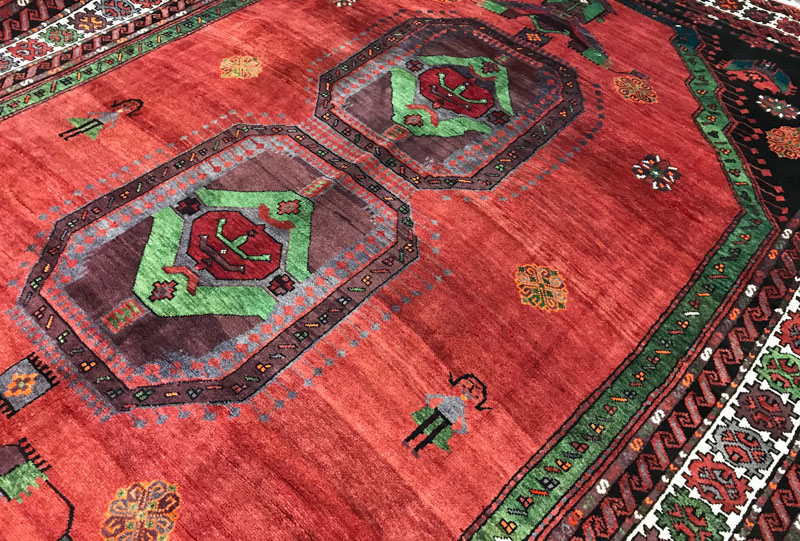
Boncuk– Anatolian blue bead, often with an ‘eye’ said to protect against evil.
Boteh– A curved motif, similar to the paisley pattern, derived from Indian and Persian Flowers.
Caravanserai– A Central Asian inn, or overnight stopping place.
Carding – The process of pulling wool through a spiked ‘comb’ to align the fibres before spinning.
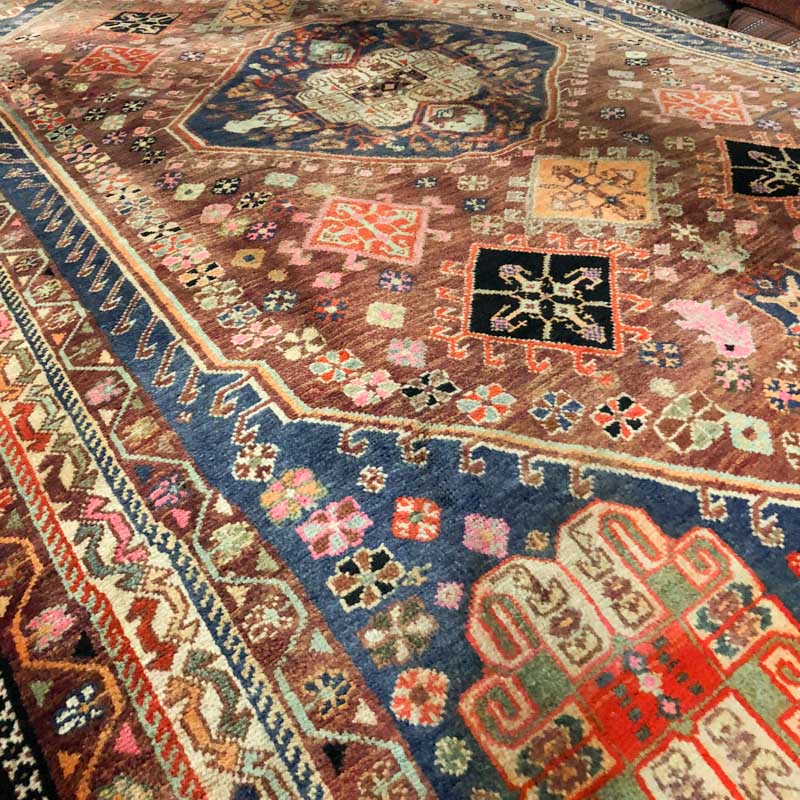
Chahar Mahal– A district mainly peopled by Bakhtiyari villagers in the foothills of the Zagros Mountains, west of Isfahan.
Chanteh – A single bag used to hold domestic and small personal items. Also known as a canta and chanta.
Cicim – A Turkish word for a kilim made using the supplementary weft technique.
Çuval (Juval) – A rectangular bag used to store and transport goods.
DOBAG– A substantial weaving and dyeing project in Turkey, which promotes the use of vegetable dyes and traditional patterns among village weavers.
Fars Province– Southern Persia’s most important administrative province, home to the Qashqai and Khamseh Confederacies, Lurs, Leks and other Persian Tribes.
Flatweave– A rug or textile woven without a pile.
Gabbeh- A term used by Lurs, Qashqai and other southern Persian tribes to describe a style of pile rug, usually loosely woven and decorated with bold, primitive patterns.
Gelim – A Persian word for a kilim also spelled Khilim, Kileem, gilim, ghilim, dilim, a form of flatweaving associated principally with Anatolia.
Ghudjeri– A Central Asian textile woven in warp-faced patterning.
Gul– A small motif or medallion, most commonly Turkoman. Derived from the Persian word for ‘flower’ and traditionally applied to repeating patterns in Turkoman weavings.
Hazara- A tribal group from north-central Afghanistan.
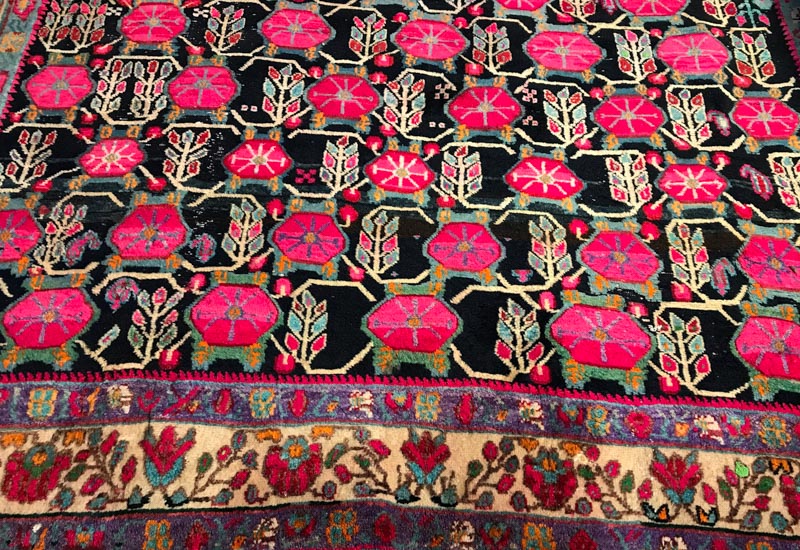
Heybe– (Turkish) - a double-pannier bag used to carry goods on the back of a donkey, horse or camel.
Horizontal Loom– A ground loom used mostly by nomadic people.
Ikat– A dye resist technique.
Indigo- A natural dyestuff, used to produce blue.
Jajim– The Persian name for narrow strips woven in warp faced patterning, which can be sewn together to make larger pieces; or the name for these larger pieces themselves.
Juval (Chuval) - A rectangular bag used to store and transport goods.
Karyola – Originally meaning bedstead, this word is now used to describe carpets made to cover beds, between 130cm x 190cm and 150cm and 200cm.
Kashkuli (Qashkuli) –A Qashqai tribe well known for their weavings, most of which reveal strong urban influences and fine workmanship.
Kazakh (Kazak)– A tribal group from Central Asia.
Khamseh– A tribal group from south Persia. Formerly a collection of five ethnically diverse tribes in southern Persia, mostly migratory, but with some settled members. They lived in the area to the west of the Afshars and east of the Qashqai territories. They were the source of many south Persian rugs in highly traditional patterns.
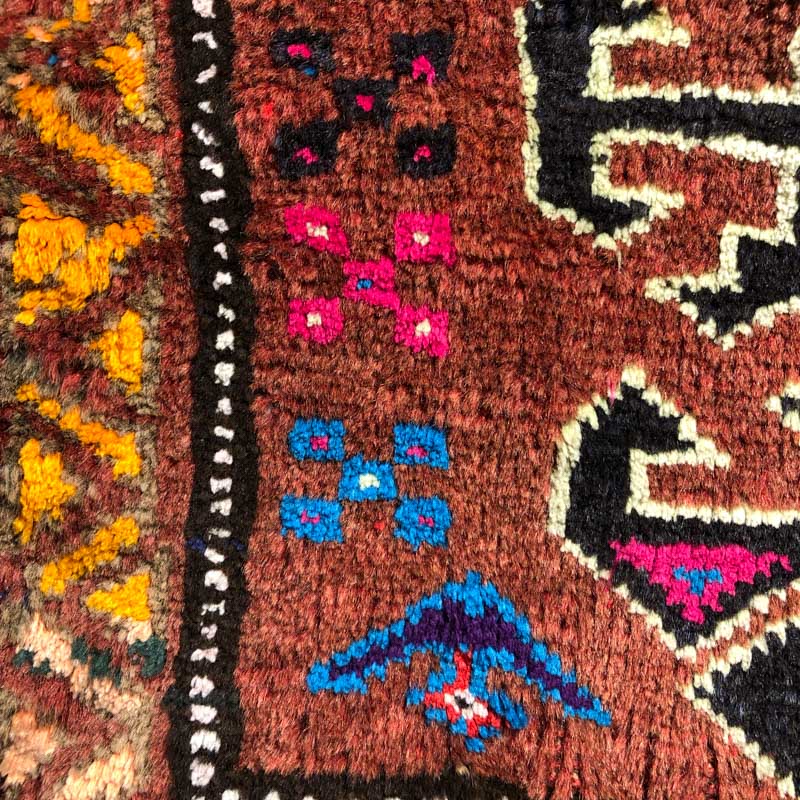
Khan- A tribal chief.
Khorjin – Also known as heybe in Turkey. A double-pannier bag used to carry goods on the back of a donkey, horse or camel.
Kilim – Also spelled Kelim, Gelim, Khilim, Kileem, gilim, ghilim, dilim, a form of flatweaving associated principally with Anatolia..
Kirghiz– A tribal group from Central Asia.
Khorasan– A large district in north eastern Persia, the capital of which is the shrine city of Mashad.
Kurds– One of the largest weaving groups living in Turkey, Iraq and Persia.
Kutchi– A nomadic group from Central Asia.
Lurs– A native Persian tribe which incorporates both nomadic and settled elements, spread over Luristan Province in western Persia, in territories to the south in Fars Province, and in some other parts of Persia. Luri people are found in both Qashqai and Khamseh Confederacies and in Afshar-dominated districts south of Kerman. “Luri” refers to the Persian dialect spoken by both Lurs and Bakhtiyaris.
Madder – A natural dyestuff used to produce red.
Maffrash– A box shaped storage chest made from flatwoven textile, used for storing bedding and clothing (cradle).
Medallion – A decorative pattern usually found in the field of a rug.
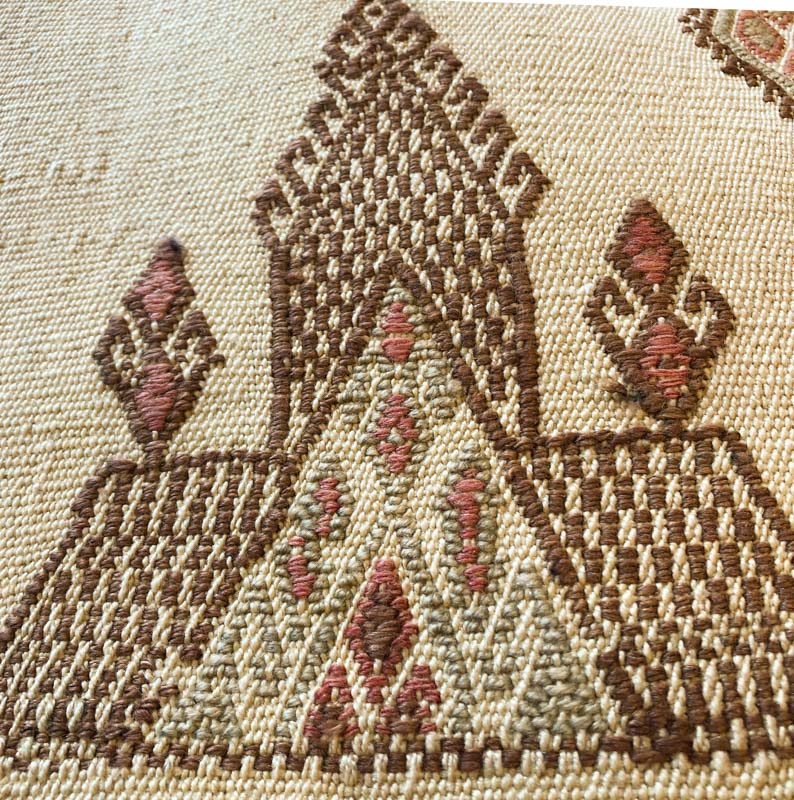
Mihrab– The prayer niche in a mosque, depicted in prayer rugs by a triangular, square or rounded form. The mihrab in a rug is always pointed towards Mecca for prayers.
Mordant– A substance used to enable dye to penetrate yarn and adhere to it, and to make the colour fast.
Motif– A distinctive element of recurring feature of a pattern.
Namazlik(from namaz– prayer). A term for prayer rug, most often used in the context of Turkoman weaving.
Nazarlik– An Anatolian talisman (eye).
Palas– A Caucasian word for a kilim.
Purdah– A cover, curtain or screen used to separate women from men.
Qashqai– Southern Persia’’s largest tribal confederacy composed mostly of Turkic speaking peoples, also known as Qashgai, Qeshqayı, Ghashghai, Ghashghay, Gashgai, Gashgay, Kashkai, Qashqay, Qashqa'i, Ghashghaei, Kashqai to name a few!!
Sarköy – or Sharkyoy– Name for kilims made in Thrace.
Saf– A multiple prayer arch kilim or rug.
Seccade– A prayer rug. Possibly never used as such but in very popular sizes ranging from about 120cm x 160cm to 140cm x 175cm.
Selvedge – The outer warps of the rug on the long sides, which are overcast to form firm braided edges.
Shahsavan– A tribal group from north west Persia.
Shiraz– The capital of Fars Province, and a major centre for the sale of south Persian tribal rugs.
Slitweave– A Kilim Rug weaving technique that leaves a vertical slit between two blocks of colour.
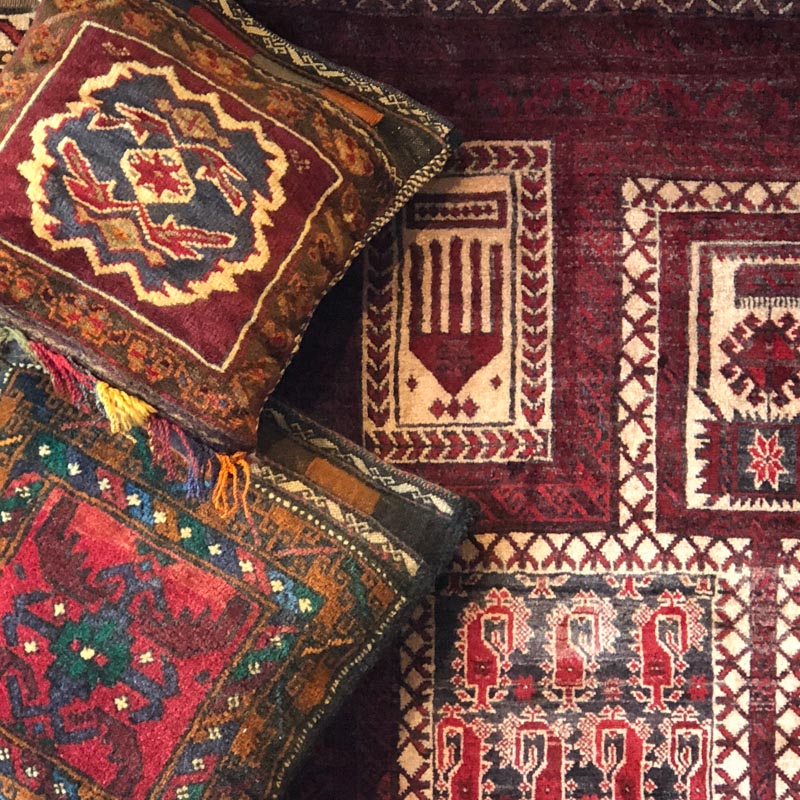
Sofra– An eating cloth on which meals are set out, or a square cloth used in the preparation of bread.
Soumak– A term used for weft wrapping and for Caucasian rugs made in weft wrapping technique.
Suzani– A term generally used to describe embroidery work, derived from the Persian word for needle.
Tablet Weaving– Also known as card weaving, a complex technique whereby narrow bands of flatweave are produced.
Tekke– One of the Turkoman tribal groups.
Torba– A small rectangular tribal bag used for domestic articles.
Turkoman– A tribal group spread over a wide area of Central Asia.
Turks– Term for a broad ethno-linguistic grouping encompassing Turkic-speaking residents of Anatolia and neighbouring regions, Turkic speaking tribes on the steppes, and earlier Turko-Mongolian tribes.
Vertical Loom– An upright loom usually fixed.
Warps– Threads that run from the top to the bottom of a textile or rug, forming the basis of its structure. Their ends may be left free to form fringes.
Warp Facing Pattern– A weaving technique whereby the pattern of the textile is created by the warps.
Weft– The yarn that runs widthways across the rug or textile, over and under the warps to form the weave.
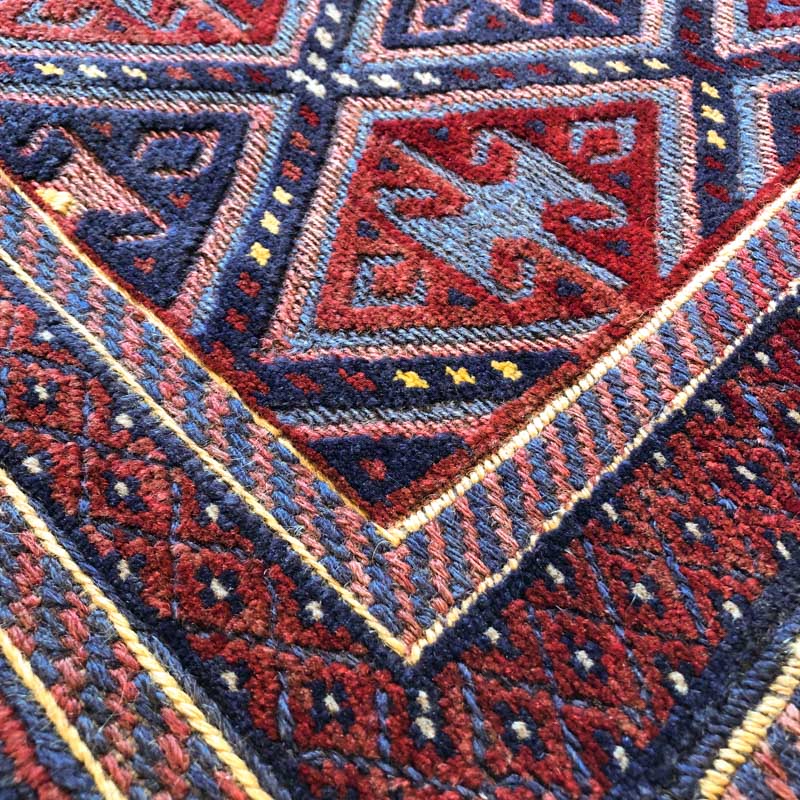
Weft Wrapping– Also known as Soumak. A weaving technique where wefts are wrapped roud the warps in a variety of combinations.
Yastik– small pile knotted cushion cover. Usually from about 40cm x 70cm to 60cm to 110cm.
Yomut– One of the Turkoman tribal groups.
Yörüks (Yürük)– Term used to refer to small groups of nomads in Anatolia. It is a generic label rather than a concrete ethnic identity. The work Yörük appears to derive from the work Yörümek meaning to walk, and is also applied to the weavings these peoples produce.
Zagros Mountains– A mountain chain in western Persia, home to a variety of native Persian and Turkic speaking nomadic weaving tribes.
Zili (Sile, Sille, Zile)- A Turkish word for the weaving technique of supplemental weft wrapping.